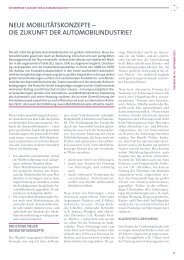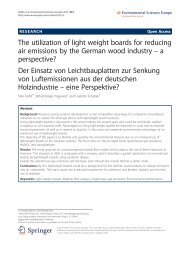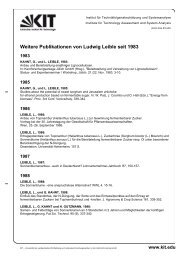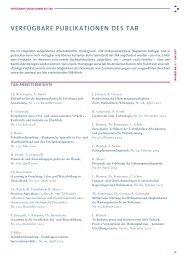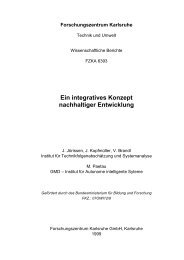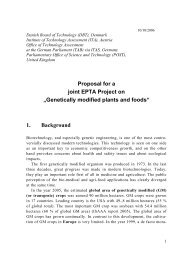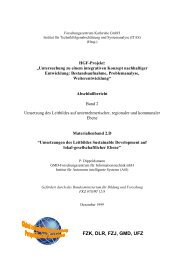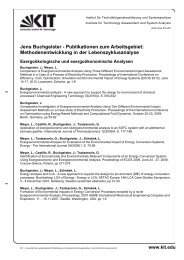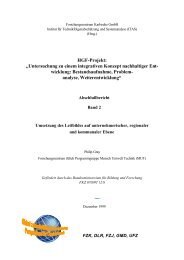Results: RFID and Identity Management in everyday life - ITAS
Results: RFID and Identity Management in everyday life - ITAS
Results: RFID and Identity Management in everyday life - ITAS
Create successful ePaper yourself
Turn your PDF publications into a flip-book with our unique Google optimized e-Paper software.
e used. But this has not yet been discussed <strong>in</strong> the parliament. At the moment an alteration of the<br />
law is prepared which will be discussed at the end of 2006 [35, 40]. There is already protest aga<strong>in</strong>st<br />
this, some say that at first the passport was to prevent look-a-like fraud but now the passport is to be<br />
a broadly applicable control <strong>and</strong> track<strong>in</strong>g mechanism [2]. Other warn for function creep whereby the<br />
technological possibilities of a central database will eventually be used, despite of privacy<br />
implications [4, 5]. There are two ma<strong>in</strong> arguments to <strong>in</strong>stall a central database; to prevent counterfeit<br />
<strong>and</strong> to fight terrorism [35]. The idea is to use a central database that can be accessed over the<br />
<strong>in</strong>ternet <strong>in</strong> order to check the legitimacy of passports. In this way it is possible to verify the data on<br />
the document itself, the data on the chip <strong>in</strong> the passport <strong>and</strong> the data <strong>in</strong> the central database which<br />
makes it more difficult to change an exist<strong>in</strong>g passport [35].<br />
An article <strong>in</strong> a Dutch newspaper stated that a central database is already constructed although the<br />
parliament has not yet decided whether such a database is wanted [4, 5]. A m<strong>in</strong>ister reacts to this by<br />
say<strong>in</strong>g that a database is not yet be<strong>in</strong>g constructed; the m<strong>in</strong>istry only exam<strong>in</strong>es the possibilities [40].<br />
The Dutch ‘College Bescherm<strong>in</strong>g Persoongegevens’ (CBP) is opposed to a central database<br />
because people have to prove their identity <strong>in</strong> many different occasions, which may cause coupl<strong>in</strong>g<br />
of different databases [59].<br />
A research <strong>in</strong> 2002 showed that facial recognition to prevent look alike fraud is <strong>in</strong>sufficient.<br />
F<strong>in</strong>gerpr<strong>in</strong>ts <strong>and</strong> iris scans are much better usable for this purpose, although the use of iris scans is<br />
more difficult to use <strong>and</strong> more expensive because of a patent on the technology. Therefore<br />
f<strong>in</strong>gerpr<strong>in</strong>ts will be used [30].<br />
The Netherl<strong>and</strong>s further held a pilot with <strong>RFID</strong>-tags <strong>in</strong> passports between August 2004 <strong>and</strong> February<br />
2005. Hereby a facial scan <strong>and</strong> f<strong>in</strong>gerpr<strong>in</strong>ts were stored on the passports chips of 14.504 participants<br />
[37]. The research cover<strong>in</strong>g this pilot only looked at the practical use of the biometric data <strong>and</strong> not at<br />
other aspects like privacy issues [37].<br />
The <strong>in</strong>troduction of the new passport <strong>in</strong> the Netherl<strong>and</strong>s has been a bit chaotic. The media soon<br />
came with stories that the photograph of many people was rejected at the municipal- or town halls<br />
were they applied for a new passport [54, 55]. Later it appeared that a smile is not forbidden although<br />
only a slight smile is accepted [52]. The rules were apparently not clear enough for all governmental<br />
organisations [52]. Apart from unclear rules still 1,5 percent of the photographs was rejected by the<br />
manufacturer after one week of issu<strong>in</strong>g the new passports [52]. There have also been a few<br />
passports with an unrecognisable photograph while the supplied photograph was meet<strong>in</strong>g the<br />
dem<strong>and</strong>s [55]. And some compla<strong>in</strong> about the dem<strong>and</strong>s for the photograph because it almost<br />
impossible to take a photograph of a baby with its mouth shut <strong>and</strong> fac<strong>in</strong>g the camera [53].<br />
There are also reports that passport have been issued without a digital scan because the provided<br />
photograph was not good enough [53, 54, 55]. People with such a passport might encounter<br />
problems when travell<strong>in</strong>g [54].<br />
There have been different forms of protest aga<strong>in</strong>st the new <strong>RFID</strong> passport. Some started a petition <strong>in</strong><br />
order to prevent the <strong>in</strong>troduction [49]. Others even give the advice to put the passport <strong>in</strong> the<br />
microwave <strong>in</strong> order to destroy the <strong>RFID</strong>-chip [58].<br />
And some have questions about track<strong>in</strong>g <strong>and</strong> trac<strong>in</strong>g, especially about the possible coupl<strong>in</strong>g of old<br />
cases with f<strong>in</strong>gerpr<strong>in</strong>ts [51] There is also fear for control <strong>in</strong> general [50]. This is partly because the<br />
chip can be read from some distance as mentioned above [6]. Some therefore suggest to put<br />
alum<strong>in</strong>ium foil around the passport [60].<br />
Germany<br />
Germany <strong>in</strong>troduced the biometric <strong>RFID</strong> passport (called ePass) <strong>in</strong> November 2005 [1]. In March<br />
2007 f<strong>in</strong>gerpr<strong>in</strong>ts will also be stored on the chip [44].. Later additional biometric data can be added,<br />
like an iris scan <strong>and</strong> some genetic <strong>in</strong>formation.<br />
German biometric passports are produced by the German Federal Pr<strong>in</strong>t<strong>in</strong>g Office (Bundesdruckerei),<br />
us<strong>in</strong>g chips supplied by Philips <strong>and</strong> Inf<strong>in</strong>eon Technologies [20].<br />
Data stored on the German e-passport chips will be encrypted us<strong>in</strong>g the RSA public-key<br />
cryptosystem [20].<br />
In Germany the idea has been put forward to sell personal data to cover the high costs of the<br />
passport [18]. These costs could rise to about €270 when more biometric data is stored <strong>in</strong> 2008 [22].<br />
49



